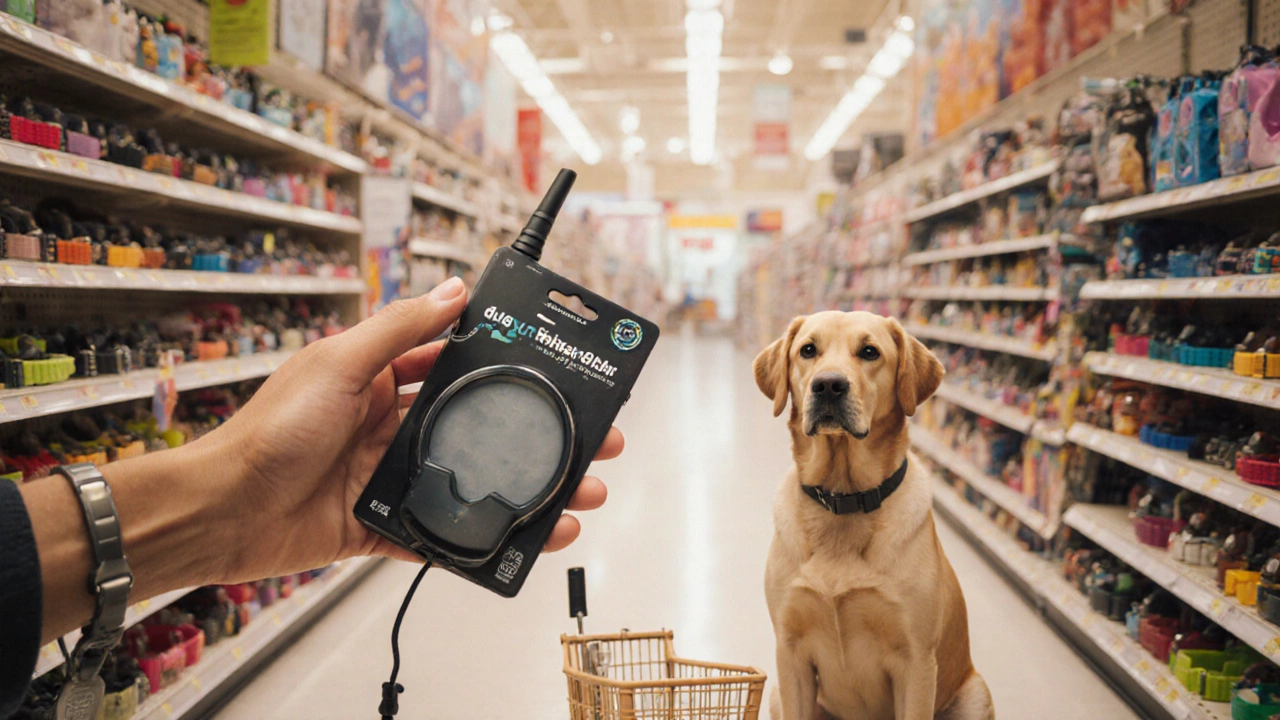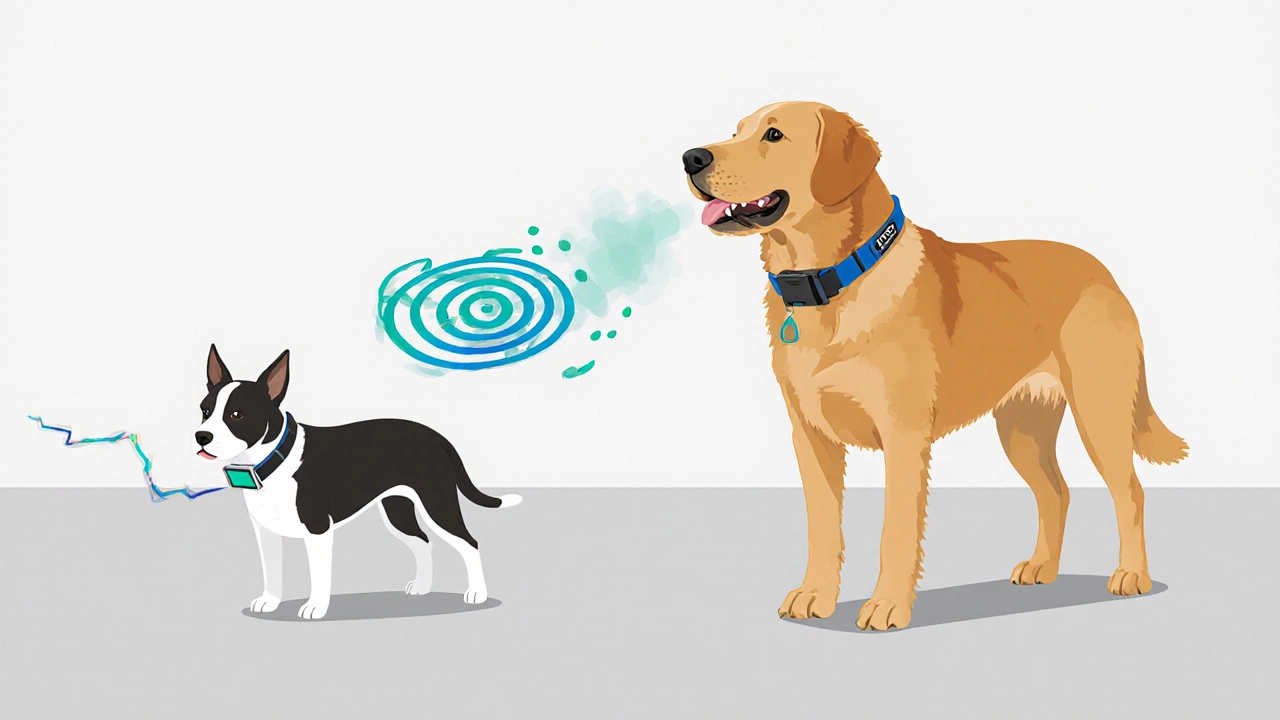
Shock Collar vs E-Collar Comparison Tool
Shock Collar
A basic electronic collar that delivers a single-wave static shock to interrupt unwanted behavior.
E-Collar (Static Only)
An advanced electronic collar with adjustable static shock levels and programmable settings.
Vibration Collar
A humane alternative that uses vibration to get your dog's attention without pain.
Citronella Collar
Delivers a burst of citronella spray to discourage unwanted behaviors without pain.
Key Differences Summary
Shock Collar vs E-Collar
- Shock collars deliver a fixed static shock (1-10 levels)
- E-collars offer programmable levels (1-30 levels)
- E-collars support multiple correction modes (static, vibration, citronella)
- E-collars are generally more expensive ($120-$250)
Safety & Legal Considerations
- Shock collars require veterinary sign-off in New Zealand
- E-collars also require veterinary sign-off in New Zealand
- Vibration and citronella collars don't require sign-off
- Always start with low intensity and adjust carefully
If you’ve ever walked into a pet store and saw a shelf full of electronic dog collars, you’ve probably wondered which one actually fits your pup’s needs. The big question that pops up again and again is: what’s the difference between a shock collar and an e‑collar? Below we break down the tech, the training theory, the legal landscape and the safety tips you need, so you can decide confidently.
Quick Takeaways
- Both shock collars and e‑collars deliver an electrical stimulus, but the intensity, waveform and control options differ.
- E‑collars usually allow programmable levels and multiple correction modes (static, vibration, citronella).
- Legal restrictions vary by country; in New Zealand any device that can cause pain requires a veterinarian or qualified trainer’s sign‑off.
- Safety hinges on proper fit, correct level setting, and limiting session length.
- Alternatives such as vibration or citronella collars can be effective for dogs that are sensitive to static correction.
Defining the Devices
At first glance, a Shock Collar is a handheld remote that sends a brief electrical pulse to a metal contact on the dog’s neck. The pulse is typically a single‑wave, high‑voltage static discharge designed to startle the animal and interrupt unwanted behavior.
An E‑Collar (short for electronic collar) is a broader term that includes shock collars but also adds programmable features: you can select static shock, vibration, or even citronella spray from the same remote. Modern e‑collars often store up to 30‑40 levels of intensity and let you set a “training mode” that changes how the stimulus is delivered.
How They Work - The Science Behind the Stimulus
Both devices rely on a simple physics principle: a small, high‑voltage electric current passes through the metal contacts on the collar, creating a quick muscle contraction. The difference lies in waveform shape and duration.
- Shock Collar: Usually a square‑wave pulse lasting 0.2‑0.4 seconds. The voltage can peak at 2,500V, but the current is micro‑amps, so the sensation feels like a sharp tap.
- E‑Collar (static mode): Allows you to choose between square, sinusoidal or pulsed waveforms. This lets you start at a low, barely noticeable level and gradually increase if needed.
- Vibration Mode: Uses a motor to produce a buzz. No electricity passes through the dog’s skin, making it a painless alternative.
- Citronella Mode: Releases a burst of citronella spray onto the dog’s nose, which most dogs find unpleasant without causing pain.
Understanding the waveform matters because a smoother sinusoidal pulse is often perceived as less harsh than a jagged square pulse, even if the voltage is similar.

Legal and Ethical Landscape
In many countries, shock‑type devices are regulated under animal welfare legislation. NewZealand’s Animal Welfare Act 1999 classifies any device that can cause pain as a “restricted training aid.” A veterinarian or a certified dog trainer must approve the use, and the device must be clearly labelled with safety warnings.
Australia bans the sale of shock collars for any dog under 12weeks, while the UK permits them only for professional use under a licensing scheme. In the United States, regulations vary by state; some, like California, have outlawed devices that emit more than 100V, effectively banning most shock collars for civilian owners.
Ethically, the consensus among reputable trainers (e.g., those certified by the International Association of Canine Professionals) is to start with the least aversive method-vibration or citronella-before moving to static correction, and to discontinue use once the behavior is reliably under control.
Choosing the Right Collar for Your Dog
When you’re standing in the aisle, ask yourself these five questions:
- What behavior am I correcting? Recall training (e.g., “come”) often works with low‑level static or vibration. Aggression or chasing wildlife may need a higher static setting. \n
- How sensitive is my dog? Small breeds and older dogs tend to react more strongly to static shock. A vibration or citronella collar might be sufficient.
- Do I have professional guidance? If you’re working with a certified trainer, they can calibrate the appropriate intensity and teach you correct timing.
- What’s my budget? Basic shock collars can start at $30USD, while feature‑rich e‑collars with GPS, activity tracking and multiple stimulus options can exceed $200USD.
- Am I prepared for maintenance? Batteries (usually AA or lithium) need replacement every 3‑6months for frequent use.
Below is a quick side‑by‑side view of the most common collars on the market:
| Feature | Shock Collar | E‑Collar (static only) | Vibration Collar | Citronella Collar |
|---|---|---|---|---|
| Stimulus Types | Static shock only | Static shock (adjustable levels) | Vibration | Citronella spray |
| Intensity Range | 1‑10 (fixed) | 1‑30 (programmable) | Low‑medium | Mild‑medium |
| Battery Life (continuous use) | ~200hrs | ~150hrs | ~300hrs | ~250hrs |
| Typical Price (USD) | $30‑$70 | $120‑$250 | $40‑$90 | $35‑$80 |
| Legal Restrictions (NZ) | Veterinarian sign‑off required | Veterinarian sign‑off required | No sign‑off needed | No sign‑off needed |
Safety Tips Everyone Should Follow
Even the most reputable device can cause harm if misused. Keep these guardrails in mind:
- Fit the collar properly. The band should sit just above the shoulders, with the metal contacts making light skin contact-no more than a finger’s thickness of space.
- Start low. Begin at the lowest level that registers a faint tingle for static collars. Increase only if the dog ignores the cue after several correct repetitions.
- Limit session length. No training session should exceed 10minutes without a break; prolonged exposure can cause stress or skin irritation.
- Watch for signs of distress. Excessive panting, whining, or attempts to chew off the collar mean you need to stop immediately.
- Maintain the device. Check battery voltage monthly, inspect the metal contacts for corrosion, and replace a worn band within six months.

Alternative Training Tools
If the ethical debate around static correction feels too heavy, consider these alternatives that many trainers swear by:
- Clicker Training. Uses a distinct sound to mark the exact moment a desired behavior occurs, followed by a treat.
- Head Halters. Gives you gentle control over the dog’s direction without applying pain.
- Long Leash Recall. Teaches a reliable “come” command with distance reinforcement, often combined with high‑value rewards.
- Positive‑Only E‑Collars. Some newer models only offer vibration and citronella modes, eliminating static shock altogether.
Maintaining Your Collar for Longevity
Even the best‑priced e‑collar can last years with regular care. Here’s a quick checklist:
- Wipe the band with a damp cloth after each use; avoid harsh chemicals that can degrade the contact plates.
- Store the remote in a cool, dry place; extreme heat can shorten battery life.
- Run a self‑test (most remotes have a “buzz‑only” button) monthly to confirm the device still emits a signal.
- Replace batteries with the same brand and capacity to maintain voltage consistency.
- Inspect the strap for fraying; a broken strap can cause the collar to ride up, increasing the risk of skin burns.
Final Thoughts on shock collar vs e-collar
Both tools have a place in the modern trainer’s toolbox, but they are not interchangeable. A shock collar is a single‑purpose device that delivers a static pulse; an e‑collar is a multi‑function platform that can be dialed down to vibration or citronella, giving you a gentler learning curve. The key is to pair the right device with the right dog, under professional guidance, and to always prioritize humane, reward‑based methods first.
Frequently Asked Questions
Can I use a shock collar on a puppy?
Most animal‑welfare agencies advise against using any static correction on puppies under 12weeks. Their skin is sensitive, and they haven’t yet learned basic commands. Start with a clicker or treat‑based system instead.
Do e‑collars work for large breeds?
Yes, but the intensity range needs to be higher for a heavyweight Labrador compared to a small Terrier. Choose a model that offers at least 20‑30 programmable levels and test the lowest level first.
Is it legal to own a shock collar in NewZealand?
Yes, but you must have a written approval from a registered veterinarian or a certified dog trainer. The device must be clearly labelled with safety warnings and used only for training, not punishment.
How often should I replace the battery?
For daily users, replace AA batteries every 3‑4months. If you use the collar only for occasional field work, a yearly change is usually enough. Always keep a spare set handy.
What’s the biggest mistake new owners make?
Starting at a high intensity and expecting instant results. This can traumatize the dog and damage trust. The safe route is low‑level start, consistent timing, and rewarding correct behavior.








Write a comment